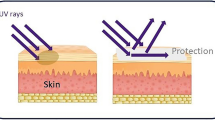Abstract
The oxidizing capacity and skin penetration of a commercial nanosized ZnO, Nanosun™ (Micronisers-Australia), were evaluated in vitro using porcine skin. Nanosun™ was initially characterized regarding its photo-reactivity and size distribution. An assay using methylene blue was performed to confirm the Nanosun™ photo-reactivity by exposing the labile molecule to UVA irradiation in the presence and absence of the nanosized ZnO. The nanosized ZnO was photo-reactive, reducing the methylene blue concentration to 7% while its concentration remained constant in the control formulation (without ZnO). The product label states that the average particle size is 30 nm. X-ray diffraction, nitrogen sorption and UV-spectrophotometry confirmed the presence of nanometric particles of approximately 30 nm. On the other hand, laser diffractometry showed micrometric particles in the size distribution profile. These analyses indicated that the nanoparticles are arranged as agglomerates and aggregates of micrometric proportions ranging from 0.6 to 60 µm. The skin lipid peroxidation was determined by the formation of thiobarbituric acid reactive species (TBARS) and quantified by UV-spectrophotometry. When exposed to UVA radiation the nanosized ZnO applied porcine skin showed a lower production of TBARS (7.2 ± 1.5 nmol g−1) than the controls, the MCT applied porcine skin (18.4 ± 2.8 nmol g−1) and the blank porcine skin (14.0 ± 2.0 nmol g−1). The penetration of ZnO nanoparticles was studied by scanning electron microscopy and energy dispersive X-ray spectroscopy. The tested ZnO particles did not penetrate into viable layers of the intact porcine skin. The particles tend to accumulate on the skin folds and in these regions they may penetrate into the horny layer.
Similar content being viewed by others
Notes and references
F. Afaq, V. M. Adhami and H. Mukhtar, Photochemoprevention of ultraviolet B signaling and photocarcinogenesis, Mutat. Res., 2005, 571, 153–173.
S. K. Jain and N. K. Jain, Multiparticulate carriers for sun-screening agents, Int. J. Cosmet. Sci., 2010, 32, 89–98.
B. D. More, Physical sunscreens: on the comeback trail, Indian J. Dermatol. Venerol. Leprol., 2007, 73, 80–85.
G. M. Murphy, Sunblocks: mechanisms of action, Photodermatol. Photoimmunol. Photomed., 1999, 15, 34–36.
N. Serpone, D. Dondi and A. Albini, Inorganic and organic UV filters: Their role and efficacy in sunscreens and suncare products, Inorg. Chim. Acta, 2007, 360, 794–802.
V. Sharma, R. Shukla, N. Saxena, D. Parmar, M. Das and A. Dhawan, DNA damaging potential of zinc oxide nanoparticles in human epidermal cells, Toxicol. Lett., 2009, 185, 211–218.
S. Hayashia, H. Takeshitaa, N. Nagaoa, O. Nikaidob and N. Miwaa, The relationship between UVB screening and cytoprotection by microcorpuscular ZnO or ascorbate against DNA photodamage and membrane injuries in keratinocytes by oxidative stress, J. Photochem. Photobiol., B, 2001, 64, 27–35.
K. Schilling, B. Bradford, D. Castelli, E. Dufour, F. Nash, W. Pape, S. Schulte, I. Tooley, J. van den Boschi and F. Schellauf, Human safety review of “nano” titanium dioxide and zinc oxide, Photochem. Photobiol. Sci., 2010, 9, 495–509.
Z. Szikszai, Z. S. Kertesz, E. Bodnar, I. Major, I. Borbiro, A. Z. Kiss and J. Hunyadi, Nuclear microprobe investigation of the penetration of ultrafine zinc oxide into intact and tape-stripped human skin, Nucl. Instrum. Methods Phys. Res., Sect. B, 2010, 268, 2160–2163.
N. A. Monteiro-Riviere, K. Wiench, R. Landsiedel, S. Schulte, A. O. Inman and J. E. Riviere, Safety evaluation of sunscreen formulations containing titanium dioxide and zinc oxide nanoparticles in UVB sunburned skin: an in vitro and in vivo study, Toxicol. Sci., 2011, 123, 264–280.
S. R. Pinnell, D. Fairhurst, R. Gillies, M. A. Mitchnick and N. Kollias, Microfine Zinc Oxide is a Superior Sunscreen Ingredient to Microfine Titanium Dioxide, Dermatol. Surg., 2000, 26, 309–314.
A. Rampaul, I. P. Parkin and L. P. Cramer, Damaging and protective properties of inorganic components of sunscreens applied to cultured human skin cells, J. Photochem. Photobiol., A, 2006, 191, 138–148.
S. Sapino, M. E. Carlotti, G. Caron, E. Ugazio and R. Cavalli, In silico design, photostability and biological properties of the complex resveratrol/hydroxypropyl-ß-cyclodextrin, J. Inclusion Phenom. Macrocyclic Chem., 2009, 63, 171–180.
A. W. Pacek, C. C. Man and A. W. Nienow, On the sauter mean diameter and size distributions in turbulent liquid/liquid dispersions in a stirred vessel, Chem. Eng. Sci., 1998, 53, 2005–2011.
S. M. Soosen, B. Lekshmi and K. C. George, Optical properties of ZnO nanoparticles, SB Academic Review, 2009, 1&2, 57–65, XVI.
M. S. Roberts, M. J. Roberts, T. A. Robertson, W. Sanchez, C. Thörling, Y. Zou, X. Zhao, W. Becker and A. V. Zvyagin, In vitro and in vivo imaging of xenobiotic transport in human skin and in the rat liver, J. Biophoton., 2008, 1, 478–493.
M. E. Darvin, K. Konig, M. Kellner-Hoefer, H. G. Breunig, W. Werncke, M. C. Meinke, A. Patzelt, W. Sterry and J. Lademann, Safety assessment by multiphoton fluorescence/second harmonic generation/hyper-Rayleigh scattering tomography of ZnO nanoparticles used in cosmetic products, Skin Pharmacol. Physiol., 2012, 25, 219–226.
I. C. Külkamp, B. D. Rabelo, S. J. Berlitz, M. Isoppo, M. D. Bianchin, S. R. Schaffazick, A. R. Pohlmann and S. S. Guterres, Nanoencapsulation Improves the In Vitro Antioxidant Activity of Lipoic Acid, J. Biomed. Nanotechnol., 2011, 7, 598–607.
Author information
Authors and Affiliations
Corresponding author
Additional information
Electronic supplementary information (ESI) available. See DOI: 10.1039/c3pp50373a
Rights and permissions
About this article
Cite this article
Detoni, C.B., Coradini, K., Back, P. et al. Penetration, photo-reactivity and photoprotective properties of nanosized ZnO. Photochem Photobiol Sci 13, 1253–1260 (2014). https://doi.org/10.1039/c3pp50373a
Received:
Accepted:
Published:
Issue Date:
DOI: https://doi.org/10.1039/c3pp50373a




